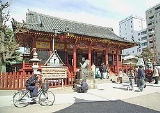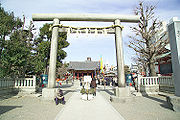
Asakusa Shrine
Encyclopedia
, also known as Sanja-sama ("Shrine of the Three Gods"), is one of the most famous Shinto
shrines in Tokyo
, Japan
. Located in Asakusa
, the shrine honors the three men who founded the Sensō-ji
. Asakusa Shrine is part of a larger grouping of sacred buildings in the area. It can be found on the east side of the Sensō-ji down a street marked by a large stone torii
.
 An example of the gongen-zukuri style of architecture, Asakusa Shrine was commissioned by Tokugawa Iemitsu
An example of the gongen-zukuri style of architecture, Asakusa Shrine was commissioned by Tokugawa Iemitsu
and constructed in 1649 during Japan's Edo Period
. It was constructed in order to honor the three men who established and constructed the Sensō-ji. The legend states that two brothers, fishermen named Hinokuma Hamanari and Hinokuma Takenari, found a bosatsu
Kannon statuette caught in a fishing-net in the Sumida River
on May 17, 628.
The third man, a wealthy landlord named Hajino Nakatomo, heard about the discovery and approached the brothers to whom he delivered an impassioned sermon about the Buddha. The brothers were very impressed and subsequently converted to the Buddhist religion. The Kannon statue was consecrated in a small temple by the landlord and the brothers who thereafter devoted their lives to preaching the way of Buddhism. This temple is now known as the Sensō-ji. Asakusa Shrine was built in order to worship these men as deities. The shrine and its surrounding area and buildings have also been the site of many Shinto and Buddhist festivals for centuries. The most important and famous of these festivals is Sanja Matsuri
, held in late May.
Unlike many other structures in the area, including the Sensō-ji, the shrine (along with the Nitenmon) survived the Tokyo air raids of 1945
. Because of this rich history, it was designated an Important Cultural Property
by the Japanese government in 1951.
Shinto
or Shintoism, also kami-no-michi, is the indigenous spirituality of Japan and the Japanese people. It is a set of practices, to be carried out diligently, to establish a connection between present day Japan and its ancient past. Shinto practices were first recorded and codified in the written...
shrines in Tokyo
Tokyo
, ; officially , is one of the 47 prefectures of Japan. Tokyo is the capital of Japan, the center of the Greater Tokyo Area, and the largest metropolitan area of Japan. It is the seat of the Japanese government and the Imperial Palace, and the home of the Japanese Imperial Family...
, Japan
Japan
Japan is an island nation in East Asia. Located in the Pacific Ocean, it lies to the east of the Sea of Japan, China, North Korea, South Korea and Russia, stretching from the Sea of Okhotsk in the north to the East China Sea and Taiwan in the south...
. Located in Asakusa
Asakusa
is a district in Taitō, Tokyo, Japan, most famous for the Sensō-ji, a Buddhist temple dedicated to the bodhisattva Kannon. There are several other temples in Asakusa, as well as various festivals.- History :...
, the shrine honors the three men who founded the Sensō-ji
Senso-ji
is an ancient Buddhist temple located in Asakusa, Taitō, Tokyo. It is Tokyo's oldest temple, and one of its most significant. Formerly associated with the Tendai sect, it became independent after World War II. Adjacent to the temple is a Shinto shrine, the Asakusa Shrine.- History :The temple is...
. Asakusa Shrine is part of a larger grouping of sacred buildings in the area. It can be found on the east side of the Sensō-ji down a street marked by a large stone torii
Torii
A is a traditional Japanese gate most commonly found at the entrance of or within a Shinto shrine, where it symbolically marks the transition from the profane to the sacred...
.
History

Tokugawa Iemitsu
Tokugawa Iemitsu was the third shogun of the Tokugawa dynasty. He was the eldest son of Tokugawa Hidetada, and the grandson of Tokugawa Ieyasu. Iemitsu ruled from 1623 to 1651.-Early life :...
and constructed in 1649 during Japan's Edo Period
Edo period
The , or , is a division of Japanese history which was ruled by the shoguns of the Tokugawa family, running from 1603 to 1868. The political entity of this period was the Tokugawa shogunate....
. It was constructed in order to honor the three men who established and constructed the Sensō-ji. The legend states that two brothers, fishermen named Hinokuma Hamanari and Hinokuma Takenari, found a bosatsu
Bodhisattva
In Buddhism, a bodhisattva is either an enlightened existence or an enlightenment-being or, given the variant Sanskrit spelling satva rather than sattva, "heroic-minded one for enlightenment ." The Pali term has sometimes been translated as "wisdom-being," although in modern publications, and...
Kannon statuette caught in a fishing-net in the Sumida River
Sumida River
The is a river which flows through Tokyo, Japan. It branches from the Arakawa River at Iwabuchi and flows into Tokyo Bay. Its tributaries include the Kanda and Shakujii rivers....
on May 17, 628.
The third man, a wealthy landlord named Hajino Nakatomo, heard about the discovery and approached the brothers to whom he delivered an impassioned sermon about the Buddha. The brothers were very impressed and subsequently converted to the Buddhist religion. The Kannon statue was consecrated in a small temple by the landlord and the brothers who thereafter devoted their lives to preaching the way of Buddhism. This temple is now known as the Sensō-ji. Asakusa Shrine was built in order to worship these men as deities. The shrine and its surrounding area and buildings have also been the site of many Shinto and Buddhist festivals for centuries. The most important and famous of these festivals is Sanja Matsuri
Sanja Matsuri
, or Sanja Festival, is one of the three great Shinto festivals in Tokyo, along with the Kanda Matsuri and Sannō Matsuri. It is considered one of the wildest and largest. The festival is held in honor of Hinokuma Hamanari, Hinokuma Takenari and Hajino Nakatomo, the three men who established and...
, held in late May.
Unlike many other structures in the area, including the Sensō-ji, the shrine (along with the Nitenmon) survived the Tokyo air raids of 1945
Bombing of Tokyo in World War II
The bombing of Tokyo, often referred to as a "firebombing", was conducted by the United States Army Air Forces during the Pacific campaigns of World War II. The U.S. mounted a small-scale raid on Tokyo in April 1942, with large morale effects...
. Because of this rich history, it was designated an Important Cultural Property
Important Cultural Properties of Japan
The term is often shortened into just are items officially already classified as Tangible Cultural Properties of Japan by the Japanese Agency for Cultural Affairs and judged to be of particular importance to the Japanese people....
by the Japanese government in 1951.
See also
- KaminarimonKaminarimonThe is the outer of two large entrance gates that ultimately leads to the Sensō-ji in Asakusa, Tokyo, Japan. The gate, with its lantern and statues, is popular with tourists. It stands 11.7 m tall, 11.4 m wide and covers and area of 69.3 m2.- History :The Kaminarimon was first...
- HōzōmonHozomonThe is the inner of two large entrance gates that ultimately leads to the Sensō-ji in Asakusa, Tokyo. A two-story gate , the Hōzōmon's second story houses many of the Sensō-ji's treasures. The first story houses two statues, three lanterns and two large sandals...
- List of Shinto shrines

